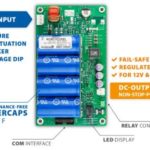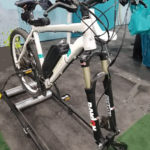Supercapacitors based on carbon nanotube technology are about to make the jump from laboratory curiosity to mass production.
NAWA Technologies in France says it will soon begin the mass production phase of its next-generation ultracapacitor, the Ultra Fast Carbon Battery. Over the coming year, a first-of-its-kind ultracapacitor cell production line will be installed at the company’s Aix-en-Provence facility. At full production, NAWA expects to hit a capacity of over 100,000 cells per month.
 NAWA says the cells will be shipped globally for various uses in a wide range of electrical systems including power tools, automated guided vehicles and sensor-based IoT markets.
NAWA says the cells will be shipped globally for various uses in a wide range of electrical systems including power tools, automated guided vehicles and sensor-based IoT markets.
The attraction of the new ultracaps is their ability to offer five times more power than existing ultracapacitors. They can also be combined with lithium-ion batteries to provide a better balance between power and energy.
The new ultracaps get their performance qualities from their use of vertically aligned carbon nanotubes as an energy storage medium. A typical ultracapacitor consists of two electrodes (positive and negative) immersed in electrolyte and a separator that electrically isolates them. Nanotube-based ultracaps are typically electrical double-layer capacitors (EDLCs). The EDLC is charged and discharged by the creation and release of the electrical double layers through the accumulation of electrolyte ions at the electrode/electrolyte interface. In EDLCs, the capacitance comes from electrostatic interactions of electrons and dielectric materials on interfaces of electrodes and electrolytes. Energy is stored in the double layers. It is the large surface-area and the extremely short distance between the double layers that contribute to the high specific capacitance of nanotube-based EDLCs.
Nawa says the carbon nanotubes it will mass produce will also go into making electrodes for lithium batteries. The large surface area of the nanotube material makes for a good electrode thanks to the numerous reaction sites it provides for lithium ions.
Total charging time for the new ultracaps is on the order of ten seconds, and Nawa says the devices can handle a million charge/discharge cycles. Energy density is about five times that of similar ultracaps. That said, the energy density of the Nawa ultracaps still lags that of batteries, storing perhaps a quarter of the power lithium cells of a given volume can hold. And like other ultracaps, Nawa’s units lose around 15% of their stored energy daily. Nevertheless, Nawa says they can handle a range of temperatures and environments that would be challenging for ordinary batteries.






A couple details. A million cycles in electronics is not much. Many capacitors do that in a day at 60x/second.
Next assuming they hit 5x better, that means li-ion is still 6x less weight, space, cost.
And can beat the SC in output, charging speed, life .
And li-ion is getting much better, lower cost. The best thing for this is likely as a li-ion cell electrode backbone.
A million cycles is good for a supercap. Consider this passage from the Arrow Electronics site:
For a lifespan comparison, consider that while electrolytic capacitors have an unlimited number of charge cycles, lithium-ion batteries average between 500 and 10,000 cycles. Supercapacitors, however, have a lifespan ranging from 100,000 to a million cycles.https://www.arrow.com/en/research-and-events/articles/supercapacitor-vs-battery-ultracapacitor-pros-and-cons